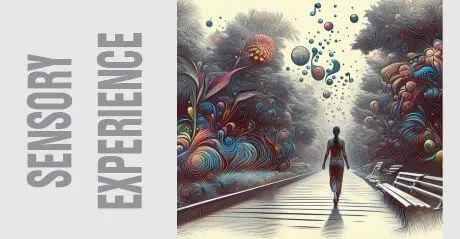Last updated on December 25th, 2024 at 02:07 am
Understand how sensory experience enhances awareness and enriches daily life and its impact on perception, cognition, and well-being.
If your skin, eyes, nose, ear, and tongue do not fascinate you, then I don’t know what will.
These organs are connecting windows through which we interact with our world.
Your senses play a vital role in how you perceive and interact with your environment, enriching your sense of agency.
Sensory enhancement techniques can heighten your awareness of the present moment and enhance your perception of the world.
By honing your senses, you enhance your ability to perceive your surroundings, enabling connection with the environment.
This article will explore the concept of sensory enhancement, its potential benefits, and practical techniques to heighten your sensory experiences for a more enriched life.
See sensory activities for toddlers.
Table of Contents
- What is Sensory Experience?
- Multi Sensory Experience
- According to Locke, All Knowledge Begins with Sensory Experience
- Importance and Benefits of Sensory Experience in Everyday Life
- The Five Sensory Organs
- Enhancing Sensory Experiences
- Role of Mindfulness and Presence in Amplifying Sensory Experiences
- The Connection between Sensory Experience and Well-being
- Sensory Experiences in Various Settings
- Examples of Sensory Experiences in Specific Settings
- How to Create Sensory Experiences in Everyday Life
- Sensory Experiences for Children and their Developmental Benefits
- Sensory Experiences for Adults and their Stress-relieving Effects
- Tailoring Sensory Experiences Based on Age and Individual Preferences
- The Future of Sensory Experiences
- Challenges of Sensory Experience
- Frequently Asked Questions
- Conclusion
What is Sensory Experience?

Simply put, sensory encounter is the way you perceive and interact with the world around you through your senses.
It is the process of receiving and interpreting information from your environment through your senses, including sight, sound, touch, taste, and smell.
It is important in everyday life because it helps you understand and make sense of the world around you.
For example, sensory play can help children develop language skills, fine motor skills, and cognitive behavior.
Related: Sensing vs Intuition: The Differences
Multi Sensory Experience
A multi-sensory experience is an experience that engages multiple senses simultaneously, such as sight, hearing, touch, taste, and smell.
It involves receiving and processing information from various sensory channels simultaneously, creating a more immersive and impactful experience.
For example, a multi-sensory dining experience may involve not only experiencing the taste of the food but also incorporating visual elements such as presentation and decoration, aromatic scents, ambient music or sounds, and tactile sensations through the texture of the food or the utensils used.
Similarly, in virtual reality (VR) or augmented reality (AR) experiences, users can engage multiple senses by wearing headsets or using devices that provide visual and auditory stimuli, while haptic feedback technology can add a sense of touch to further enhance immersion.
Multi-sensory can evoke strong emotional and cognitive responses, as they stimulate various senses simultaneously, providing a more holistic and memorable experience.
They are often used in marketing, entertainment, art, therapy, and education to create powerful and engaging experiences for individuals.
Related: Components of Physical Self-care
According to Locke, All Knowledge Begins with Sensory Experience
According to John Locke, all knowledge begins with sensory encounters.
He believed that our minds are like a blank slate, or tabula rasa, at birth, and that our understanding of the world is built upon the information we receive through our senses.
Locke argued that our senses provide us with raw data, which our minds then process and organize to form knowledge and ideas.
He emphasized the importance of observation, perception, and reflection in the acquisition of knowledge.
Through sensory encounters, we establish the foundation upon which reasoning and understanding are built, enabling us to navigate and comprehend the complexities of the world around us.
Importance and Benefits of Sensory Experience in Everyday Life

Sensory encounters play a crucial role in shaping our perceptions, emotions, and overall well-being in daily life.
Here are several key reasons why sensory encounter are important in our daily lives:
Perception and Understanding: Our senses are the primary channels through which we perceive and interpret the world. They provide us with information about our environment, allowing us to navigate and make sense of the world.
Safety and Survival: Sensory encounters are some of the primal instincts essential for our safety and survival. The ability to hear approaching danger, see potential hazards, and feel changes in temperature or texture can help us respond quickly and appropriately to threats or challenges.
Emotional Well-being: Sensory perception can have a profound impact on our emotions. Pleasant smells, soothing sounds, and visually appealing environments can contribute to positive emotions and a sense of well-being. Conversely, unpleasant sensory stimuli may lead to stress or discomfort.
Memory and Learning: Our senses are closely tied to memory and learning. Studies have shown that sensory-rich experiences are more likely to be remembered, and sensory stimuli can enhance the learning process.
Enhanced Enjoyment of Life: Engaging our senses can significantly enhance our enjoyment of life. Whether savoring the taste of a delicious meal, appreciating the beauty of nature, or listening to music, sensory perception contributes to the richness of our daily lives and can bring joy and fulfillment.
Cultural and Social Interaction: Sensory encounters often play a crucial role in cultural practices and social interactions. Shared sensory experiences, such as enjoying a meal together, participating in festivals, or attending concerts, can strengthen social bonds and enhance a sense of community.
Stress Reduction and Relaxation: Certain sensory activities, such as aromatherapy, calming sounds, or gentle tactile sensations, have been linked to stress reduction and relaxation. Engaging with these experiences can contribute to mental well-being and help alleviate the pressures of daily life.
The Five Sensory Organs
Sensory experiences play a crucial role in your everyday life. Imagine a world where you couldn’t smell the aroma of freshly baked bread or see the vibrant colors of a dazzling sunset.
Without your senses, life would feel incomplete and dull. Sensory encounters allow you to interact with your surroundings and make sense of the world.
The five senses are the fundamental abilities through which humans perceive and interact with the world around them.
They include sight, hearing, taste, smell, and touch. Each of these senses plays a distinct role in collecting information from our environment and transmitting it to our brain for interpretation.
Let’s take a deeper look and explain each of these five senses and their roles in sensory interpretation:
Sight
Sight, or vision, is the ability to perceive light and distinguish objects, colors, and shapes.
The eyes capture light and send signals to the brain, where they are processed to create visual images.
Sight allows us to navigate the world, recognize faces, read, and perceive an array of visual stimuli.
Our eyes allow us to see the world in all its glory. We can appreciate the breathtaking beauty of nature, the details of artwork, and the expressions on people’s faces.
Our sense of sight helps us navigate our environment, avoid obstacles, and read written words.
Can you imagine trying to get around without the ability to see?
Hearing
Hearing, or audition, is the ability to perceive sound vibrations. Our ears capture sound waves and convert them into electrical signals that are transmitted to the brain.
This enables us to perceive and recognize various types of sounds, including voices, music, and environmental noises.
Sounds help us communicate, understand one another, and alert us to potential danger.
Taste
Taste, or gustation, allows us to recognize different flavours. Taste buds on our tongue detect chemical compounds in food and send signals to the brain, which interprets them as sweet, sour, salty, bitter, or umami (savory).
Through taste, we experience pleasure or displeasure in our food choices.
Smell
Smell, or olfaction, allows us to detect and identify scents. Our nose contains olfactory receptors that can recognize a multitude of odour molecules.
When these molecules interact with the receptors, signals are sent to the brain, enabling us to distinguish various smells and triggering memories and emotional responses.
Touch
Touch, or tactition, is the sense that allows us to feel physical sensations through our skin. It includes the perception of pressure, temperature, texture, pain, and vibration.
Touch helps us interact with our surroundings, feel objects, determine their temperature, and sense if something causes pleasure or discomfort.
It provides us with the invaluable experience of feeling the warmth of a gentle hug, the softness of a cozy blanket, and the gentle breeze brushing against our skin.
Sensory Experience Examples of the Sensory Organs
Sight: Watching a sunset, reading a book, or recognizing a familiar face.
Hearing: Listening to music, hearing a doorbell ring, or engaging in a conversation.
Taste: Savoring a delicious meal, biting into a juicy fruit, or experiencing the bitterness of coffee.
Smell: Enjoying the aroma of freshly baked bread, smelling the freshness of flowers, or detecting the scent of rain.
Touch: Feeling the softness of a pet’s fur, experiencing the warmth of sunlight on your skin, or sensing the pressure of a handshake.
Enhancing Sensory Experiences

Engaging our senses can heighten our awareness, bring us joy, and enhance our overall well-being. It allows us to fully immerse ourselves in the present moment and connect with our surroundings on a deeper level.
To enhance sensory organs experiences, here are a few tips and suggestions:
1. Engaging with Nature and the Outdoors
Spending time in nature can be incredibly invigorating for our senses.
Taking walks in the park, hiking through forests, or simply sitting by the beach can offer a range of sensory stimuli such as the sound of rustling leaves, the sight of vibrant colors, the touch of various textures, the smell of fresh air, and the taste of natural foods.
Paying attention to these sensory details can enrich our connection with nature.
2. Trying New Activities and Exposing Yourself to Different Environments
Stepping out of your comfort zone and trying new activities can expose you to a variety of sensory organ experiences.
Whether it’s trying a new sport, learning a musical instrument, or experimenting with different forms of art, these activities can stimulate your senses and increase your sensory awareness.
Additionally, visiting different environments, such as bustling cities or serene countryside, can provide unique sensory encounters.
3. Exploring Different Cultures and their Sensory Rituals
Every culture has its own set of sensory rituals and experiences. Exploring these can offer a deeper understanding of different ways to engage your senses.
This can involve trying out different cuisines, attending cultural festivals, participating in traditional ceremonies, or learning about sensory practices like meditation or aromatherapy.
Experiencing these cultural nuances can broaden your perspective and introduce you to new sensory dimensions.
Role of Mindfulness and Presence in Amplifying Sensory Experiences
By practicing mindfulness, you can fully immerse yourself in the present moment and focus on the sensations you are experiencing.
Instead of being distracted or consumed by thoughts, you can redirect your attention to the sensory details around you.
By being fully present, you can notice the subtleties and nuances of the sensory organ experiences, making them more vivid and enjoyable.
Mindfulness also allows you to appreciate and savour these moments, leading to a greater sense of fulfillment and gratitude.
The Connection between Sensory Experience and Well-being
Sensory organ experiences play a crucial role in our overall well-being. Our senses have a direct impact on our mood, emotions, and cognitive functioning.
Engaging in positive sensory organ experiences can enhance our well-being by providing pleasure, relaxation, and a sense of satisfaction.
For example, enjoying a beautiful sunset, listening to soothing music, or indulging in a delicious meal can uplift our mood and increase our feelings of happiness and contentment.
On the other hand, negative sensory encounter can have adverse effects on our well-being.
Unpleasant smells, loud noises, or uncomfortable textures can cause stress, anxiety, and irritability.
How Sensory Experiences Can Reduce Stress and Anxiety
Sensory organ experiences have the potential to reduce stress and anxiety by providing a calming and grounding effect on our nervous system.
When your senses are engaged in pleasurable and relaxing activities, your body releases endorphins – hormones responsible for feelings of well-being, thereby reducing stress and anxiety levels.
For instance, engaging in activities such as aromatherapy which is using essential oils, enjoying a warm bath, or practicing mindfulness which is focusing on the present moment through senses can help activate the body’s relaxation response.
These experiences shift our attention away from stressful thoughts and promote a sense of calmness.
Understanding the Role of Sensory Experiences in Self-care Practices
Sensory organ experiences play a significant role in self-care practices. Engaging in sensory activities is a way to nurture and take care of oneself.
When you intentionally create and enjoy positive sensory organ experiences, you prioritize your well-being and overall mental health.
Incorporating sensory experiences into self-care routines can help you manage stress, prevent burnout, and enhance your emotional well-being.
Activities such as taking a walk in nature, listening to soothing music, practicing yoga, or engaging in creative hobbies can all contribute to a holistic and rejuvenating self-care practice.
Sensory Experiences in Various Settings
Sensory encounters vary depending on the setting and environment. Here are some examples in different places:
Home: At home, sensory encounters can be diverse. The smell of home-cooked food, the feel of a comfortable couch or soft bed, the sound of a crackling fireplace, or the sight of artwork on the walls can all contribute to sensory encounters.
Nature: Being in natural surroundings can offer a variety of sensory organ experiences. The sound of birds chirping, the smell of flowers or trees, the feel of grass or sand beneath your feet, or the sight of a beautiful landscape can all engage different senses in nature.
Cities: Urban environments offer unique sensory encounters. The bustling noise of traffic, the aroma of street food, the feel of city pavement or park benches, or the sight of city skylines or vibrant street art can all create distinct sensory experiences in a city setting.
Examples of Sensory Experiences in Specific Settings
| Examples of Sensory Experiences |
|---|
|
Spa: A spa is designed to engage multiple senses for relaxation and rejuvenation. Soft ambient music, tranquil lighting, calming scents like lavender or eucalyptus, the feel of warm towels or water during treatments, and the taste of refreshing drinks or healthy snacks can all provide sensory perception in a spa. Restaurant: Restaurants aim to create pleasurable experiences through various means. The aroma of freshly cooked food, the sounds of sizzling or clinking glasses, the sight of beautifully presented dishes, the feel of comfortable seating or a warm ambiance, and the taste of well-prepared cuisine all contribute to sensory perceptions in a restaurant. |
How to Create Sensory Experiences in Everyday Life
Mindful Practices: Engage in mindfulness techniques like deep breathing or meditation to focus on the present moment and heighten sensory awareness.
Surroundings: Personalize your surroundings by incorporating scented candles, soothing music, or textured fabrics to create a comfortable and sensory-rich environment at home.
Outdoor Exploration: Spend time outdoors and connect with nature. Take a walk in a park, visit a garden, or plan hikes to experience the sights, sounds, and smells of natural surroundings.
Explore Your City: Take time to explore your city and visit different neighborhoods, parks, or cultural events to engage with the sensory organ experiences it has to offer.
Try New Culinary Experiences: Experiment with various cuisines, flavours, and cooking techniques to enjoy a range of tastes and smells. Dining at new restaurants or cooking at home with different ingredients can create unique experiences with food.
Sensory Experiences for Children and their Developmental Benefits
Sensory organ experiences play a crucial role in the development of children. By engaging their senses, children are able to explore, learn, and make sense of the world around them.
Some sensory encounters that benefit different age groups include:
Infants: Providing babies with sensory experiences such as soft textured toys, gentle music, and soothing scents can help stimulate their senses, promoting brain development and enhancing their cognitive, emotional, and physical growth.
Toddlers: Sensory encounters like playing with colorful, textured materials, sand, and water, or engaging in messy play activities like finger painting help toddlers develop their fine motor skills, hand-eye coordination, and sensory perception. It also promotes creativity and problem-solving abilities.
Preschoolers: Sensory experiences that involve various textures, sounds, colors, and smells continue to stimulate the development of a preschooler’s senses. This can be achieved through activities such as exploring nature, engaging in sensory bins or games, experimenting with different art mediums, or engaging in pretend play that stimulates their imagination.
Sensory Experiences for Adults and their Stress-relieving Effects
Sensory encounters are not limited to children; they can also greatly benefit adults, especially when it comes to stress relief and relaxation.
As adults often face various stressors in their daily lives, engaging in these experiences can help them unwind and find peace. Some examples include:
Sound Therapy: Listening to calming music, nature sounds, or even white noise can help relax the mind and reduce stress levels. This can be achieved through activities like meditation, using noise-canceling headphones, or incorporating soothing sounds into your environment.
Aromatherapy: Essential oils and scented candles can create a calming ambiance, promote relaxation, and relieve stress. Different scents have unique effects on the mind and body, such as lavender for relaxation or peppermint for energy.
Touch: Engaging in activities that provide tactile stimulation, such as getting a massage, taking a bath with soft, scented bath salts, or using stress-relieving gadgets like stress balls or fidget toys, can help adults release tension and promote relaxation.
Tailoring Sensory Experiences Based on Age and Individual Preferences
When tailoring sensory perceptions, it is essential to consider both age and individual preferences.
Each age group has different sensory needs and abilities. Additionally, everyone has unique preferences and sensitivities towards sensory input.
Some considerations include:
Age-appropriate Activities: Sensory encounters should be age-appropriate to ensure they are engaging, safe, and beneficial for individuals. For example, young children may enjoy sensory bins with colorful materials, while adults may prefer more sophisticated sensory activities like gardening or cooking.
Preferences and Sensitivities: It is important to consider individual preferences and sensitivities towards sensory input. While some individuals may enjoy certain smells or textures, others may find them overwhelming or unpleasant.
The Future of Sensory Experiences
Innovations and Advancements in Sensory Technology
Innovations and advancements in sensory technology are likely to play a major role in shaping the future of sensory encounters.
As technology progresses, new devices will be developed that can stimulate our senses in more immersive and realistic ways.
This includes advancements in haptic technology, such as gloves or suits that provide a sense of touch, as well as olfactory devices that can create realistic smells.
These technologies will enhance our ability to engage with and experience the world around us.
Visual Reality and Augmented Reality
Virtual reality (VR) and augmented reality (AR) are already beginning to revolutionize sensory encounters.
VR allows users to be fully immersed in a digitally simulated environment, while AR overlays digital information onto the real world.
Both technologies can stimulate multiple senses, including sight and sound, and are already being used in a variety of fields, such as gaming, education, tourism, and healthcare.
They offer the potential to transport individuals to different places, create highly realistic simulations, and provide interactive and engaging experiences.
Technology-enhanced Sensory Experiences
Technology-enhanced sensory encounters offer several potential benefits.
They can provide a more immersive and engaging way to learn, allowing individuals to experience situations and environments that would otherwise be inaccessible.
For example, VR can help medical students practice surgeries or simulate dangerous scenarios for training purposes.
Additionally, technology can also enhance entertainment experiences, such as gaming or watching movies, by providing a more realistic and interactive environment.
Challenges of Sensory Experience
Challenges of sensory organ experience are the difficulties or obstacles you may face when it comes to perceiving and processing sensation through your senses.
These challenges can vary in nature and can affect different individuals in different ways.
Here are a few of the common challenges:
1. Sensory Processing Disorders
Some individuals may have difficulties in accurately and efficiently processing sensory information received through their senses.
This can result in sensory overload or sensitivity, where even normal levels of sensory input can be overwhelming.
On the other hand, some individuals may experience sensory under-responsiveness, where they have a limited response or awareness of sensory stimuli.
2. Sensory Integration Issues
Sensory integration is the brain’s ability to organize and interpret multiple sensory inputs simultaneously.
When there is a breakdown in this process, it can lead to challenges in coordinating and integrating sensory information.
This can affect your ability to engage in everyday activities such as focusing, maintaining balance, or performing fine motor tasks.
3. Sensory Deprivation or Limited Sensory Input
Certain environments or conditions may lack the necessary sensory stimulation, resulting in a limited sensory experience.
For example, individuals who are visually impaired may miss out on visual cues, while those who are hearing impaired may struggle to perceive sound, leading to challenges in communication and social interactions.
4. Sensory Overload
On the other end of the spectrum, you may also face challenges when exposed to an excessive amount or intensity of sensory input.
Overwhelming or intense sensory stimulation can lead to difficulties in concentration, mental fatigue, anxiety, or even physical discomfort.
5. Cross-sensory Issues
Some individuals may experience challenges in the integration and coordination of sensory information across different modalities.
For example, they may struggle to simultaneously process auditory and visual information or have difficulty perceiving the spatial orientation of objects.
6. Sensory-specific Challenges
Different senses can pose their own unique challenges. For instance, individuals with taste or smell disorders may have difficulties in identifying or distinguishing different flavours or odours, impacting their enjoyment of food or potential food-related hazards.
These challenges can greatly impact a person’s daily life, including their learning, communication, social interactions, and overall well-being.
Nevertheless, various interventions and therapies can help with sensory challenges minimize their impact, and improve their sensory experience.
Frequently Asked Questions
What is an example of a sense experience?
An example of a sense experience is tasting a delicious meal, where the taste buds on our tongue perceive the flavors.
What is an example of a multisensory experience?
Watching a movie with surround sound and 3D visuals is an example of a multisensory experience, engaging sight and hearing simultaneously.
What do we mean by sensory?
Sensory refers to anything related to our senses, which include sight, hearing, taste, touch, and smell.
What is direct sensory experience?
Direct sensory organ experience refers to firsthand encounters with stimuli through our senses, without any intermediaries or filters.
How do sense organs help you understand your surroundings?
Sense organs, such as the eyes, ears, nose, tongue, and skin, gather information from the environment and transmit it to the brain for interpretation, helping us understand our surroundings.
How do our sensory organs detect the world around us?
Our sensory organs detect the world around us by receiving external stimuli, converting them into electrical signals, and transmitting them to the brain for processing and interpretation.
What are the organs that help you to sense your surroundings?
The organs that help us sense our surroundings include the eyes for vision, ears for hearing, nose for smell, tongue for taste, and skin for touch.
Conclusion
Your sensory organs play a crucial role in connecting you with your surroundings.
They allow you to perceive and interpret the world around you, providing valuable sensory information about your environment.
From the taste of a delicious meal to the vibrant colors of a sunset, your senses enhance your sensory experience and help you navigate through life.
Through your senses, you establish a profound connection with the external world and that is why it is important to appreciate and nurture these sensory organ experiences, as they enrich your life and contribute to your overall well-being.
References:
- https://www.verywellmind.com/perception-and-the-perceptual-process-2795839
- https://benjamins.com/catalog/celcr.24
Pious Clements is the insightful voice behind "The Conducts of Life" blog, where he writes about life ethics, self-development, life mastery, and the dynamics of people and society.
With a profound understanding of human behaviuor and societal dynamics, Pious offers thought-provoking perspectives on ethical living and personal growth.
Through engaging narratives and astute observations, he inspires readers to navigate life's complexities with wisdom and integrity, encouraging a deeper understanding of the human experience and our place within society.

